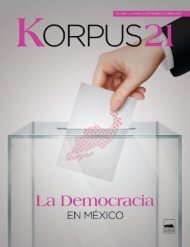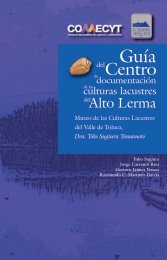Create successful ePaper yourself
Turn your PDF publications into a flip-book with our unique Google optimized e-Paper software.
ERIC VAN YOUNG, THE SPHYNX OF SAN COSME: A HISTORIAN’S THOUGHTS ON WRITING A BIOGRAPHY<br />
The use of this sort of very personal document<br />
—as with autobiography, journals, personal<br />
correspondence, and even personal experience<br />
dressed as fiction, as in many novels— raises<br />
the question of the unreliable narrator, whether<br />
conscious or unconscious; that is, a narrator (in<br />
this case Lucas Alamán) who either shades the<br />
truth, misinforms, or outright lies to the reader. 22<br />
A writer or memoirist fooling her/himself would<br />
fall under this rubric, certainly by effect if not<br />
intent. Such a writer might consciously prevaricate<br />
or distort for any number of motives: to<br />
settle scores, for the purpose of self-vindication,<br />
for self-promotion, and so forth. Apart from conscious<br />
misrepresentation, unreliable narration<br />
would seem inherent in all first-person accounts<br />
and would in any case be difficult to distinguish<br />
from the point of view to be expected arising<br />
from subjectivity. The biographer may even be<br />
able to gain some leverage in decoding a personality<br />
by analyzing the mistakes or misrepresentations<br />
in the subject’s writing and comparing<br />
them to external, more “reliable” sources.<br />
Alamán was certainly no Baron von Münchausen.<br />
He made mistakes in his memorias, principally<br />
of a genealogical nature, but to the degree<br />
I have been able to check his statements, recollections,<br />
and impressions in “objective” modern<br />
historical writings, they seem truthful and accurate<br />
(Brading, 1971; Ladd, 1976). In the end there<br />
seems to be no way around this problem except<br />
reasonable caution on the part of the life-writer.<br />
There are two issues relating to sources that I<br />
want to discuss before moving on to a brief discussion<br />
about how much detail in a biography<br />
is too much, and then to a conclusion. The first<br />
of these concerns a narrative strategy (or if one<br />
prefers, an anti-narrative strategy) I employed<br />
in my book on Alaman that arose less from an<br />
abundance of documentary sources than from<br />
their absence. Although it was relatively easy<br />
to document his public life in terms of actions,<br />
it proved difficult to plumb his internal life, as<br />
I have said. An admittedly rather crude model<br />
22 The classic archetype of the “unreliable narrator” was Baron<br />
von Münchausen, as portrayed in Rudolph Erich Raspe’s<br />
1785 book Baron Münchausen’s Narrative of his Marvellous<br />
[sic] Travels and Campaigns in Russia. The historical figure<br />
was the Hanoverian aristocrat and soldier Hieronymus Karl<br />
Friedrich, Freiherr von Münchhausen (1720-1797), who became<br />
famous during his lifetime for his entertaining tall tales<br />
of his “experiences” while in the employ of the Russian Imperial<br />
army.<br />
of Alamán’s worldly presence would progress<br />
inward from the level of his actions, mostly observable<br />
since he lived so much of his life in the<br />
public eye; to his words, both uttered and written;<br />
and then to his interior life, the last being<br />
the hardest to get at. But he wrote so much, especially<br />
in private and business correspondence,<br />
and in his historical works, that I felt I might at<br />
least try to gauge the quality of his mind, and<br />
demonstrate some of his preoccupations, by<br />
taking the liberty of quoting his words at greater<br />
length than one might ordinarily expect to find<br />
in a biography. Had he been more self-revealing<br />
in a philosophical or emotional register I might<br />
not have felt compelled to do this; but to get at<br />
the man —at least at his thinking and at the style<br />
of his thought— this seemed to me justified. The<br />
fact that he was a leisurely and eloquent writer<br />
was of some help here in forestalling the boredom<br />
some readers might have experienced;<br />
whether this was a good strategy or a bad one I<br />
leave to readers to decide.<br />
The second technique I employed I have not<br />
seen much, or perhaps at all, in the many biographies<br />
I have read, and stands at the exact opposite<br />
end of the evidentiary continuum from<br />
what I discussed in the preceding paragraph.<br />
Life-writing will inevitably pause at plateaus in<br />
the subject’s life to offer a more intense discussion<br />
of this or that aspect. In writing of Lucas<br />
Alamán’s life I expanded these plateaus into<br />
more extensive interventions; this had to do<br />
not with the absence or thinness of sources on<br />
certain aspects of Alamán’s life but their abundance,<br />
which allowed me a certain experimental<br />
freedom in dealing with several important aspects<br />
of his life, chiefly in the economic realm.<br />
There are four analytical chapters in the book<br />
(aside from the final two, which discuss the<br />
writing of his monumental Historia de Méjico):<br />
on the life of his elder half-brother, the churchman<br />
Juan Bautista Arechederreta; Alamán’s<br />
involvement with British capital in the 1820s in<br />
an attempt to revive the silver mining industry;<br />
his relations over nearly thirty years with<br />
the Duque de Terranova y Monteleone; and his<br />
embroilment in the textile enterprise of Cocolapan,<br />
near Orizaba, between 1836 and 1843. Although<br />
the chapters on the mining episode and<br />
the textile enterprise are placed roughly where<br />
they occurred during his life, they share with<br />
12



![bicentenario_1[V2]](https://img.yumpu.com/68677971/1/167x260/bicentenario-1v2.jpg?quality=85)
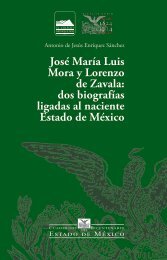
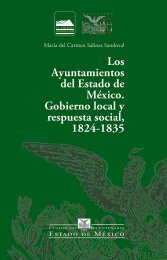

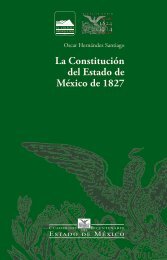
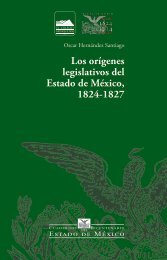
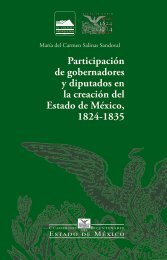
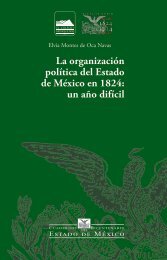
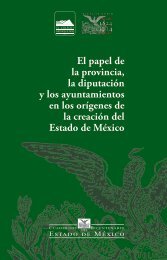
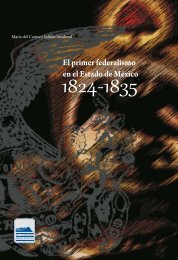
![El_primer_federalismoEM[final]_compressed (2)](https://img.yumpu.com/68483279/1/178x260/el-primer-federalismoemfinal-compressed-2.jpg?quality=85)
